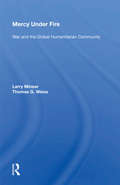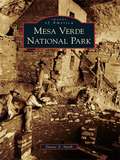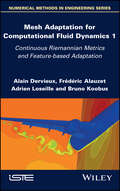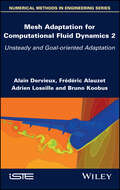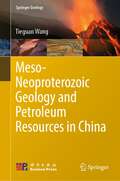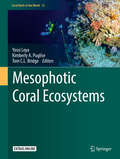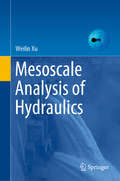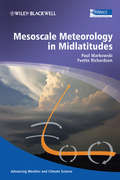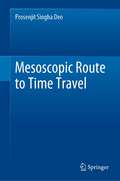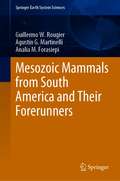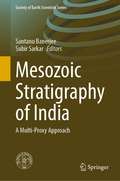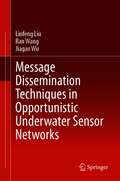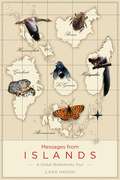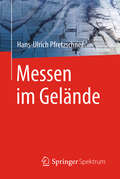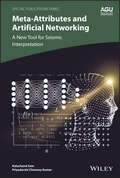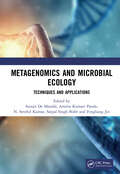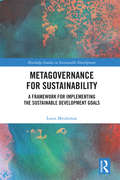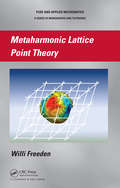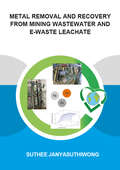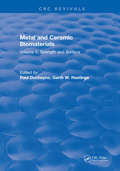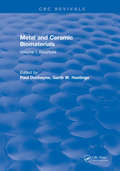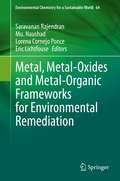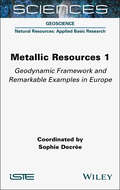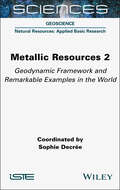- Table View
- List View
Mercy Under Fire: War And The Global Humanitarian Community
by Larry MinearFrom Bosnia to Somalia, and most recently from Rwanda to Angola and the Sudan, humanitarian aid and international interventions have gone awry. Although the need for humanitarian assistance has not diminished in the wake of the Cold War, success stories will almost certainly be harder to come by. This book addresses that grim prospect. Based on sch
Mesa Verde National Park
by Duane A. SmithMesa Verde National Park was America's first cultural park and also the world's first cultural heritage park. Created in 1906, it preserves the sites and materials of the prehistoric Puebloan people. Located in southwestern Colorado near the famous Four Corners, where the states of Colorado, Utah, Arizona, and New Mexico meet, the magnificent Mesa Verde is situated in Montezuma County, just south of Cortez and directly west of Durango. The park's rich archaeological history was played out amid some of the most ruggedly beautiful landscapes in the West. The greater story of the evolution of the park encompasses the Ute people, Theodore Roosevelt, novelist Willa Cather, and other personalities. These remarkable vintage photographs tell that saga, which is as fascinating as that of the Puebloans.
Mesh Adaptation for Computational Fluid Dynamics, Volume 1: Continuous Riemannian Metrics and Feature-based Adaptation
by Frederic Alauzet Adrien Loseille Alain Dervieux Bruno KoobusSimulation technology, and computational fluid dynamics (CFD) in particular, is essential in the search for solutions to the modern challenges faced by humanity. Revolutions in CFD over the last decade include the use of unstructured meshes, permitting the modeling of any 3D geometry. New frontiers point to mesh adaptation, allowing not only seamless meshing (for the engineer) but also simulation certification for safer products and risk prediction.Mesh Adaptation for Computational Dynamics 1 is the first of two volumes and introduces basic methods such as feature-based and multiscale adaptation for steady models. Also covered is the continuous Riemannian metrics formulation which models the optimally adapted mesh problem into a pure partial differential statement. A number of mesh adaptative methods are defined based on a particular feature of the simulation solution.This book will be useful to anybody interested in mesh adaptation pertaining to CFD, especially researchers, teachers and students.
Mesh Adaptation for Computational Fluid Dynamics, Volume 2: Unsteady and Goal-oriented Adaptation
by Frederic Alauzet Adrien Loseille Alain Dervieux Bruno KoobusSimulation technology, and computational fluid dynamics (CFD) in particular, is essential in the search for solutions to the modern challenges faced by humanity. Revolutions in CFD over the last decade include the use of unstructured meshes, permitting the modeling of any 3D geometry. New frontiers point to mesh adaptation, allowing not only seamless meshing (for the engineer) but also simulation certification for safer products and risk prediction.Mesh Adaptation for Computational Dynamics 2 is the second of two volumes and introduces topics including optimal control formulation, minimizing a goal function, and extending the steady algorithm to unsteady physics. Also covered are multi-rate strategies, steady inviscid flows in aeronautics and an extension to viscous flows.This book will be useful to anybody interested in mesh adaptation pertaining to CFD, especially researchers, teachers and students.
Meso-Neoproterozoic Geology and Petroleum Resources in China (Springer Geology)
by Tieguan WangThis book focuses on Meso- to Neoproterozoic geology and Petroleum resources in China. It offers the oldest sediments knowledge for petroleum generation, accumulation, alteration and preservation in the world. It provides a valuable contribution to the understanding of a potential Precambrian oil and gas exploration realm through well-developed Meso- to Neoproterozoic sedimentary strata with petroleum resources. This work will appeal to a wide readership, from geologists, geochemists, petroleum prospector, university faculty members to advanced students working for Precambrian and petroleum geological and geochemical research.
Mesophotic Coral Ecosystems (Coral Reefs of the World #12)
by Yossi Loya Kimberly A. Puglise Tom C.L. BridgeThis book summarizes what is known about mesophotic coral ecosystems (MCEs) geographically and by major taxa. MCEs are characterized by light-dependent corals and associated communities typically found at depths ranging from 30-40 m. and extending to over 150 m. in tropical and subtropical ecosystems. They are populated with organisms typically associated with shallow coral reefs, such as macroalgae, corals, sponges, and fishes, as well as specialist species unique to mesophotic depths. During the past decade, there has been an increasing scientific and management interest in MCEs expressed by the exponential increase in the number of publications studying this unique environment. Despite their close proximity to well-studied shallow reefs, and the growing evidence of their importance, our scientific knowledge of MCEs is still in its early stages. The topics covered in the book include: regional variation in MCEs; similarities and differences between mesophotic and shallow reef taxa, biotic and abiotic conditions, biodiversity, ecology, geomorphology, and geology; potential connectivity between MCEs and shallow reefs; MCE disturbances, conservation, and management challenges; and new technologies, key research questions/knowledge gaps, priorities, and future directions in MCE research.
Mesoscale Analysis of Hydraulics
by Weilin XuThis open access book presents a series of complicated hydraulic phenomena and related mechanism of high-speed flows in head-head dam. According to the basic hydraulic theory, detailed experiments and numerical simulations, microscopic scale analysis on cavitation bubbles, air bubbles, turbulent eddy vortices and sand grains are examined systemically. These investigations on microscopic fluid mechanics, including cavitation erosion, aeration protection, air–water flow, energy dissipation and river-bed scouring, allow a deep understanding of hydraulics in high-head dams. This book provides reference for designers and researchers in hydraulic engineering, environment engineering and fluid mechanics.
Mesoscale Meteorology in Midlatitudes
by Yvette Richardson Paul MarkowskiMesoscale Meteorology in Mid-Latitudes presents the dynamics of mesoscale meteorological phenomena in a highly accessible, student-friendly manner. The book's clear mathematical treatments are complemented by high-quality photographs and illustrations. Comprehensive coverage of subjects including boundary layer mesoscale phenomena, orographic phenomena and deep convection is brought together with the latest developments in the field to provide an invaluable resource for mesoscale meteorology students.Mesoscale Meteorology in Mid-Latitudes functions as a comprehensive, easy-to-use undergraduate textbook while also providing a useful reference for graduate students, research scientists and weather industry professionals.Illustrated in full colour throughout Covers the latest developments and research in the field Comprehensive coverage of deep convection and its initiation Uses real life examples of phenomena taken from broad geographical areas to demonstrate the practical aspects of the science
Mesoscale-Convective Processes in the Atmosphere
by Robert J. TrappThis new textbook seeks to promote a deep yet accessible understanding of mesoscale-convective processes in the atmosphere. Mesoscale-convective processes are commonly manifested in the form of thunderstorms, which are fast evolving, inherently hazardous, and can assume a broad range of sizes and severity. Modern explanations of the convective-storm dynamics, and of the related development of tornadoes, damaging "straight-line" winds, and heavy rainfall, are provided. Students and weather professionals will benefit especially from unique chapters devoted to observations and measurements of mesoscale phenomena, mesoscale prediction and predictability, and dynamical feedbacks between mesoscale-convective processes and larger-scale motions.
Mesoscopic Route to Time Travel
by Prosenjit Singha DeoThis book gives a general introduction to theoretically understand thermodynamic properties and response to applied fields of mesoscopic systems that closely relate to experiments. The book clarifies many conceptual and practical problems associated with the Larmor clock and thus makes it a viable approach to study these properties. The book is written pedagogically so that a graduate or undergraduate student can follow it. This book also opens up new research areas related to the unification of classical and quantum theories and the meaning of time. It provides a scientific mechanism for time travel which is of immense fascination to science as well as society. It is known that developments in mesoscopic physics can lead to downscaling of device sizes. So, new or experienced researchers can have a quick introduction to various areas in which they might contribute in the future. This book is expected to be a valuable addition to the subject of mesoscopic physics.
Mesozoic Mammals from South America and Their Forerunners (Springer Earth System Sciences)
by Analía M. Forasiepi Guillermo W. Rougier Agustín G. MartinelliThis book summarizes the most relevant published paleontological information, supplemented by our own original work, on the record of Mesozoic mammals’ evolution, their close ancestors and their immediate descendants. Mammals evolved in a systematically diverse world, amidst a dynamic geography that is at the root of the 6,500 species living today. Fossils of Mesozoic mammals, while rare and often incomplete, are key to understanding how mammals have evolved over more than 200 million years. Mesozoic mammals and their close relatives occur in a few dozen localities from Argentina, Brazil, Chile, Bolivia, and Peru spanning from the Mid- Triassic to the Late Cretaceous, with some lineages surviving the cataclysmic end of the Cretaceous period, into the Cenozoic of Argentina. There are roughly 25 recognized mammalian species distributed in several distinctive lineages, including australosphenidans, multituberculates, gondwanatherians, eutriconodonts, amphilestids and dryolestoids, among others. With its focus on diversity, systematics, phylogeny, and their impact on the evolution of mammals, there is no similar book currently available.
Mesozoic Stratigraphy of India: A Multi-Proxy Approach (Society of Earth Scientists Series)
by Santanu Banerjee Subir SarkarThis book envisages a multi-proxy approach using stable isotopes, geochemical proxies, magnetic susceptibility and associated biotic events for paleoclimatic and paleoenvironmental interpretations of the Mesozoic sedimentary record of India. Mesozoic rocks of India record abnormal sea level rise, greenhouse climate, intensified volcanism, hypoxia in seawater, extensive black shale deposition, and hydrocarbon occurrence. The Mesozoic has also witnessed mass extinction events, evolution of dinosaurs, and breakdown of the supercontinent Pangea and the formation of Gondwana. Although the Mesozoic geology of India has witnessed significant progress in the last century, literature survey reveals a huge gap in knowledge regarding sequence stratigraphy, chemostratigraphy and key geological events. A synthesis of sedimentological, paleontological and chemical data is included to presenting a comprehensive understanding of the Indian Mesozoic record to students, researchers and professionals.
Message Dissemination Techniques in Opportunistic Underwater Sensor Networks
by Ran Wang Linfeng Liu Jiagao WuThis book investigates the architectures and characteristics of OUSNs, the mobility models of OUSN nodes, the challenges of message dissemination, and some evaluation indexes of message dissemination. Then, this book provides some message dissemination techniques in OUSNs from the viewpoints of nodes and data messages, respectively. The proposed message dissemination techniques and their conclusions can provide some useful insights to improve the performance of data message dissemination and promote the future applications of OUSNs. Researchers and engineers in the field of underwater sensor networks can benefit from the book.
Messages from Islands: A Global Biodiversity Tour
by Ilkka HanskiFrom a small island in the Baltic Sea to the large tropical islands of Borneo and Madagascar, Messages from Islands is a global tour of these natural, water-bound laboratories. In this career-spanning work, Ilkka Hanski draws upon the many islands on which he performed fieldwork to convey key themes in ecology. By exploring the islands’ biodiversity as an introduction to general issues, Hanski helps us to learn how species and communities interact in fragmented landscapes, how evolution generates biodiversity, and how this biodiversity is maintained over time. Beginning each chapter on a particular island, Hanski dives into reflections on his own field studies before going on to pursue a variety of ecological questions, including: What is the biodiversity crisis? What are extinction thresholds and extinction debts? What can the biodiversity hypothesis tell us about rapidly increasing allergies, asthma, and other chronic inflammatory disorders? The world’s largest island, Greenland, for instance, is the starting point for a journey into the benefits that humankind acquires from biodiversity, including the staggering biodiversity of microbes in the ecosystems that are closest to us—the ecosystems in our guts, in our respiratory tracts, and under our skin. Conceptually oriented but grounded in an adventurous personal narrative, Messages from Islands is a landmark work that lifts the natural mysteries of islands from the sea, bringing to light the thrilling complexities and connections of ecosystems worldwide.
Messen im Gelände
by Hans-Ulrich PfretzschnerDer vorliegende Leitfaden erläutert Studierenden der Geowissenschaften die grundlegenden Techniken der Aufnahme geodätischer Daten, die Umsetzung solcher Daten in topographische Karten und Höhenprofile, aber auch die grundlegenden geologischen Messtechniken und die Erstellung geologischer Profile. Sowohl einfache "Freihandtechniken", die auch von einer Person beim Prospektieren angewendet werden können, wie auch der Einsatz professioneller Präzisionsinstrumente finden Eingang in dieses Buch. Im ersten Abschnitt werden Kartenkoordinatensysteme und der Umgang mit Kartenkoordinaten vorgestellt. Es schließt sich im zweiten Teil eine detaillierte Darstellung der für die Geowissenschaftlerin bzw. den Geowissenschaftler wichtigen geodätischen wie auch geologischen Messtechniken an sowie eine kurze Einführung in die Erstellung geologischer Profile. Das Lehrbuch schließt ab mit einer Instrumentenkunde, in welcher die bei den Messungen eingesetzten Instrumente vorgestellt werden.
Meta-attributes and Artificial Networking: A New Tool for Seismic Interpretation (Special Publications #76)
by Kalachand Sain Priyadarshi Chinmoy KumarMeta-Attributes and Artificial Networking Meta-Attributes and Artificial Networking A New Tool for Seismic Interpretation Seismic data gathered on the surface can be used to generate numerous seismic attributes that enable better understanding of subsurface geological structures and stratigraphic features. With an ever-increasing volume of seismic data available, machine learning augments faster data processing and interpretation of complex subsurface geology. Meta-Attributes and Artificial Networking: A New Tool for Seismic Interpretation explores how artificial neural networks can be used for the automatic interpretation of 2D and 3D seismic data. Volume highlights include: Historic evolution of seismic attributes Overview of meta-attributes and how to design them Workflows for the computation of meta-attributes from seismic data Case studies demonstrating the application of meta-attributes Sets of exercises with solutions provided Sample data sets available for hands-on exercises The American Geophysical Union promotes discovery in Earth and space science for the benefit of humanity. Its publications disseminate scientific knowledge and provide resources for researchers, students, and professionals.
Metagenomics and Microbial Ecology: Techniques and Applications
by Nachimuthu Senthil Kumar Surajit De Mandal Amrita Kumari Panda Satpal Singh Bisht Fengliang JinMicroorganisms comprise the greatest genetic diversity in the natural ecosystem, and characterization of these microbes is an essential step towards discovering novel products or understanding complex biological mechanisms. The advancement of metagenomics coupled with the introduction of high-throughput, cost-effective NGS technology has expanded the possibilities of microbial research in various biological systems. In addition to traditional culture and biochemical characteristics, omics approaches (metagenomics, metaproteomics, and metatranscriptomics) are useful for analyzing complete microbial communities and their functional attributes in various environments. Metagenomics and Microbial Ecology: Techniques and Applications explores the most recent advances in metagenomics research in the landscape of next-generation sequencing technologies. This book also describes how advances in sequencing technologies are used to study invisible microbes as well as the relationships between microorganisms in their respective environments. Features: Covers a wide range of concepts, investigations, and technological advancement in metagenomics at the global level. Highlights the novel and recent approaches to analyze microbial diversity and its functional attributes. Features a range of chapters that present an introduction to the field and functional insight into various ecosystems.
Metagovernance for Sustainability: A Framework for Implementing the Sustainable Development Goals (Routledge Studies in Sustainable Development)
by Louis MeulemanThe 17 Sustainable Development Goals (SDGs) which were adopted by the United Nations in September 2015 are universally applicable in all 193 UN Member States and connect the big challenges of our time, such as hunger and poverty, climate change, health in an urbanised environment, sustainable energy, mobility, economic development and environmental degradation. Sustainability has the characteristics of a ‘wicked problem’, for which there are no one-size-fits-all solutions. This book tests the hypothesis that the implementation of sustainable development, and in particular the 2015 SDGs, requires tailor-made metagovernance or ‘governance of governance’. This is necessary to develop effective governance and high quality and inclusive public administration and to foster policy and institutional coherence to support implementing the SDGs. Based on the growing literature on governance and metagovernance, and taking into account the specificities of societal factors such as different values and traditions in different countries, the book presents a framework for the design and management of SDG implementation. It shows how hierarchical, network and market governance styles can be combined and how governance failure can be prevented or dealt with. The book presents an overview of fifty ‘shades of governance’ which differ for each governance style, and a sketch of a concrete method to apply sustainability metagovernance. Metagovernance for Sustainability is relevant to academic and practitioner fields across many disciplines and problem areas. It will be of particular interest to scholars, students and policy-makers studying Sustainable Development, Governance and Metagovernance, Public Management and Capacity Building.
Metaharmonic Lattice Point Theory (Chapman & Hall Pure and Applied Mathematics)
by Willi FreedenMetaharmonic Lattice Point Theory covers interrelated methods and tools of spherically oriented geomathematics and periodically reflected analytic number theory. The book establishes multi-dimensional Euler and Poisson summation formulas corresponding to elliptic operators for the adaptive determination and calculation of formulas and identities of
Metal Removal and Recovery from Mining Wastewater and E-waste Leachate (IHE Delft PhD Thesis Series)
by Suthee JanyasuthiwongMetal contamination in the environment is a persisting global issue. The metal reservoirs in the earth have declined due to society’s needs and due to uncontrolled mining activities. Therefore, the idea to recover metals from waste streams has emerged. In this thesis, cost competitive technologies such as adsorption using agro-wastes and precipitation using an inverse fluidized bed (IFB) reactor were investigated, with special emphasis on the recovery of base metals. Groundnut shell showed good potential for metal (Cu, Pb and Zn) removal. From artificial neural network modeling, the performance of the sulfate reducing bacteria (SRB) was found to be strongly pH dependent; the removal efficiency of Cu and Zn in the IFB at pH 5.0 was >97%. Electronic waste is a good candidate as secondary metal resource. The recovery of Cu from computer printed circuited boards (PCBs) using biogenic sulfide precipitation was investigated as well. Using this technology, Cu could be recovered at ~0.48 g Cu/g PCBs.
Metal and Ceramic Biomaterials: Volume I: Structure
by DucheyneThe understanding of the in vivo performance of synthetic materials is largely dependent upon a profound knowledge of the properties of the materials in question. Analogous to materials science in its broadest sense, the basis for biomaterials science is formed by microstructural there. It is therefore, that in this series on structure property relationships in biomaterials a substantial part is devoted to the analysis of the basic properties of the various synthetic biomaterials. In addition, the effect of microstructural aspects on properties is considered at great length.
Metal and Ceramic Biomaterials: Volume II: Strength and Surface
by DucheyneThe understanding of the in vivo performance of synthetic materials is largely dependent upon a profound knowledge of the properties of the materials in question. Analogous to materials science in its broadest sense, the basis for biomaterials science is formed by microstructural there. It is therefore, that in this series on structure property relationships in biomaterials a substantial part is devoted to the analysis of the basic properties of the various synthetic biomaterials. In addition, the effect of microstructural aspects on properties is considered at great length.
Metal, Metal-Oxides and Metal-Organic Frameworks for Environmental Remediation (Environmental Chemistry for a Sustainable World #64)
by Eric Lichtfouse Mu. Naushad Saravanan Rajendran Lorena Cornejo PonceThis book reviews principles, techniques and applications of metal, metal oxides, metal sulfides and metal-organic frameworks for removal and degradation of pollutants. Natural materials are often much more advanced than synthetic materials in terms of circularity and are functional, often biodegradable, recyclable and generate little waste. They are, therefore, a source of inspiration for new synthetic materials. In particular, recent research has focused on various types of functional materials such as organic, inorganic, nanostructured and composites for the remediation of environmental pollution.
Metallic Resources 1: Geodynamic Framework and Remarkable Examples in Europe
by Sophie DecréeMetallic resources play a huge role in many fields: in the energy transition, the development of new technologies and the production and storage of green energy. Metallic Resources 1 presents various studies in notable European metallogenic regions or deposits that enable us to tackle the question of the concentration of metals, especially strategic metals, in various geodynamic settings. An understanding of the geological processes that lead to the formation of deposits and influence their concentrations in the Earth's crust is of the utmost importance when it comes to uncovering new mineral resources. This book puts forward various different methodological approaches necessary in the study of deposits of metallic resources, from field observations to microanalysis. A study of specific geo-politico-economic frameworks is also presented.
Metallic Resources 2: Geodynamic Framework and Remarkable Examples in the World
by Sophie DecréeMetallic resources play a huge role in many fields: in the energy transition, the development of new technologies and the production and storage of green energy. Metallic Resources 2 presents various studies in notable metallogenic regions or deposits worldwide that enable us to tackle the question of the concentration of metals, especially strategic metals, in various geodynamic settings. An understanding of the geological processes that lead to the formation of deposits and influence their concentrations in the Earth's crust is of the utmost importance when it comes to uncovering new mineral resources. This book puts forward various different methodological approaches necessary in the study of deposits of metallic resources, from field observations to microanalysis. A study of specific geo-politico-economic frameworks is also presented.
